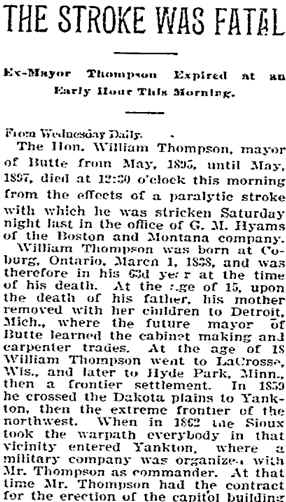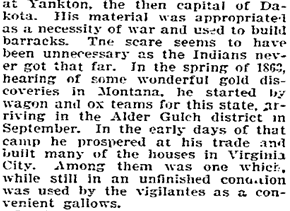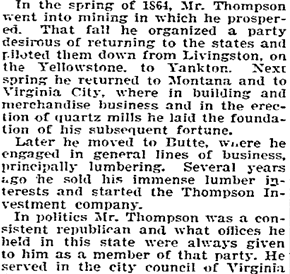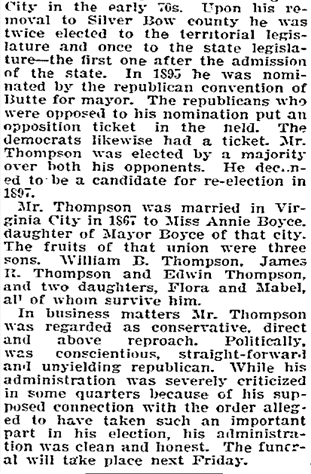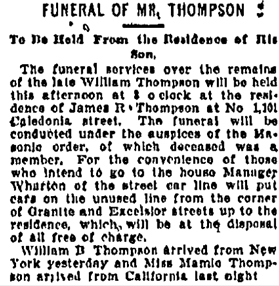|
CROSSED
THE RANGE William
Thompson, a Pioneer of the State KNOWN
ALL OVER MONTANA One
of the First to Engage in the Sawmill Business, Which He Afterward
Old residents of Helena regretted yesterday to hear of the death of
William Thompson, which occurred at Butte Tuesday night.
Mr. Thompson was one of the pioneers of the state, and had an
extensive acquaintance which was not confined to any particular section of
Montana.
Mr. Thompson was 68 years of age, but had always enjoyed excellent
health, and his death came as a shock to his family and friends. Last
Saturday afternoon he suffered a paralytic stroke.
His right side was paralyzed and he lost the power of speech.
Everything that medical science could do was done, but he never rallied
and the end came at midnight Tuesday.
Mr. Thompson went to Butte from Madison County in the early ‘80s
and established a lumber yard there. He had saw mills in many parts of the
state, but of late years he began to concentrate his commercial interests
so as to direct them from one office in Butte.
He owned mines in Madison County and in Arizona, but his chief
interest was the investment company in Butte. He was considered one of
Butte’s very wealthy men.
Mr. Thompson stood high in the Masonic lodge, having taken all
Scottish and York rites, the 32nd degree of Scottish rite,
Knights Templar, and Shrine. He was a member of Butte Lodge No. 22, A.F.
and A.M.; Deer Lodge Chapter No. 3, Royal Arch Masons; Montana Commandery
No. 3, Knights Templar; Butte consistory Scottish Rite Masons and Algeria
Temple A. and A., Order Nobles of Mystic Shrine.
Mr. Thompson was born at Coburg, Ontario, Canada, March 1, 1838.
There he lived until he was 15 years old, receiving his education in the
public schools. The father having died, Mrs. Thompson moved with her
children to the United States, locating in Detroit, Mich., in 1853, where
William learned the cabinet and carpenter trades. At the age of 18 he set
out to carve his own fortune, and proceeded to La Crosse, Wis., going from
there to High Forest, Minn, This was in 1856, and High Forest was then a
frontier settlement. He saved a little money by working at his trade and
in 1859 pushed farther west in company with Hon. Moses Armstrong,
afterward delegate to congress from Dakota. They crossed the Dakota plains
by way of New Ulm, Lake Benton, Pipestone Quarry and Sioux Falls to
Yankton, on the Missouri River, then the extreme frontier in the
northwest, arriving in the fall of 1859. In August of 1862 the Sioux
Indians took to the war path and the massacre at New Ulm and the outrages
committed elsewhere by them created considerable alarm at Yankton. The
settlers gathered at the later place and prepared for war. A
militia company was organized, of which young Thompson was a member, for
home protection, but fortunately active service was not required.
Thompson had at that time the contract for the erection of the
capitol building, or the one that was to serve as such, for the territory
of Dakota, of which, Yankton was then the capitol. His material was all on
the ground and in the war emergency it was appropriated and used to build
barracks for protection against the expected hostiles.
In the fall of 1861 a party came down the Missouri in mackinaws
from Fort Benton, then the headquarters of the American Fur company in the
northwest. They stopped at Yankton and exhibited a considerable quantity
of gold, which they said came from the mountains south of Fort Benton. The
next spring, 1862, a small party from St. Louis and other cities went up
the river on a steamboat to Benton in search of treasure, and from that
point penetrated the mountains. Among the party were two brothers named
Hulbert. They got as far a Prickly Pear Valley, near where Helena now
stands, and found some gold near Montana City, being undoubtedly the first
discoveries of those diggings which afterwards proved rich and extensive.
During all these years on the frontier, Mr. Thompson stuck
tenaciously to his trade and did not vary the rule even in Alder Gulch,
where nearly everyone else was expecting to dig a fortune out of the
ground in a short time. He took his kit of tools along with him and found
them of great service, The first winter, while the people at the camp were
idly waiting for the mining season to open, Thompson was diligently at
work making doors, frames, sashes, etc., the material for which he hewed
out of pine trees, and earned easily from $10 to $15 a day. He
subsequently formed a partnership for the building business with Mr.
Griffith. They built nearly all of the first houses in Virginia City,
among them one which was in an unfinished condition, being used by the
vigilantes as a convenient gallows on which to hand Boon, Helm, Jack
Gallagher, Frank Parish, Hxxx Lyon and “Club Foot George,”
desperadoes. This occurred in the month of January, 1864. The following
spring Mr. Thompson and his partner purchased claim No. 2, above
Fairweather’s discovery, from James Fergus and worked it that season. In
the fall of the same year he organized a party of 168 men, who wanted to
return to the states, and piloted them down the Yellowstone and Missouri
rivers in mackinaws, charging each man $25 for the trip. Mr. Thompson
returned to Montana the following spring, 1865, by steamboat up the
Missouri river to Fort Benton, from there going direct to Virginia City,
by way of Helena.
In 1866 the firm of Thompson & Griffiths commenced operation in
Helena, erecting the King, Gillett, Taylor and Thompson and several other
blocks. Those contracts were to the amount of $75,000. As early as 1868
Mr. Thompson purchased and operated a steam sawmill near Virginia City,
and continued in the business until a few years ago. He owned sawmills in
Madison, Beaverhead, Deer Lodge, Missoula and Silver Bow counties.
Mr. Thompson served in the city council of Virginia City in 1873-4
and afterwards represented Silver Bow county in three different sessions
of the legislature, in the territorial house of representative of the
Fifteenth session, in the territorial council of the Sixteenth legislature
and in the office of representative at the first session under the new
state government. He was mayor of Butte from 1895 to 1897. Mr. Thompson
was married to Annie, daughter of Maj. And Mrs. J. R. Boyce Sr., in
Virginia City, in 1867. There were five children born to Mr. and Mrs.
Thompson. Date:
Thursday, May 17, 1900
|
|
Date:
Thursday,
May 17, 1900
|
Date:
Friday, May 18, 1900
|
